From the vibrant streets of Marseille, France to the comfort of your own kitchen, embark on a culinary journey as we guide you through the step-by-step process of creating the perfect Bouillabaisse. This French inspired seafood stew offers a taste of the Mediterranean in every spoonful by combining fresh fish and seafood with a fragrant blend of onions, peppers, tomatoes, garlic, saffron, wine, and an assortment of herbs. Our version was created by my home gourmet mom, and written into the margins of one of her favorite cookbooks. It’s faster and easier than other, more traditional bouillabaisse recipes.
This post contains referral links for products I recommend. As an Amazon Associate, I earn a small commission on qualified purchases, at no cost to you.
You Will Love This Bouillabaisse Recipe!
Trust me, once you try this incredible recipe, you’ll be hooked. Despite its impressive appearance, like all of my mom’s recipes, it’s surprisingly easy to make. Plus, it’s perfect for special occasions—I’ve served it on Valentine’s Day, Mardi Gras, Christmas Eve, and for birthday dinners. In short, here’s why I highly recommend this recipe:
- Easy and impressive dish that’s elegant while still rustic.
- Flexible ingredients – add, subtract, substitute to fit your tastes and what’s available.
- Super flavorful and aromatic broth.
- Can be made 1 to 2 days ahead, refrigerated, and reheated shortly before serving.
Origins of Bouillabaisse
This iconic dish traces its roots back to the bustling port city of Marseille, located in the Provence region of southern France. It was originally created by the local fishermen as a way to make use of the unsold fish from their catch of the day. Over time, bouillabaisse evolved to include seafood as well.
What Exactly is Bouillabaisse?
Bouillabaisse is a traditional French fish and seafood stew that originated in the port city of Marseille in Provence, France. Hearty and flavorful, the primary ingredients of bouillabaisse typically include different kinds of fish such as monkfish, sea bass, flounder, or red rascasse (in the scorpion family) as well as shellfish like mussels, clams, and sometimes shrimp or crab. The broth is flavored with onions, garlic, tomatoes, saffron, and aromatic herbs found in the south of France.
Cioppino vs Bouillabaisse
Bouillabaisse is a French fish stew that typically features a variety of fish, shellfish, and aromatic herbs in a saffron-infused fish broth. Cioppino, on the other hand, is an Italian seafood stew in a tomato-based broth packed with an assortment of seafood including crab, clams, and shrimp.
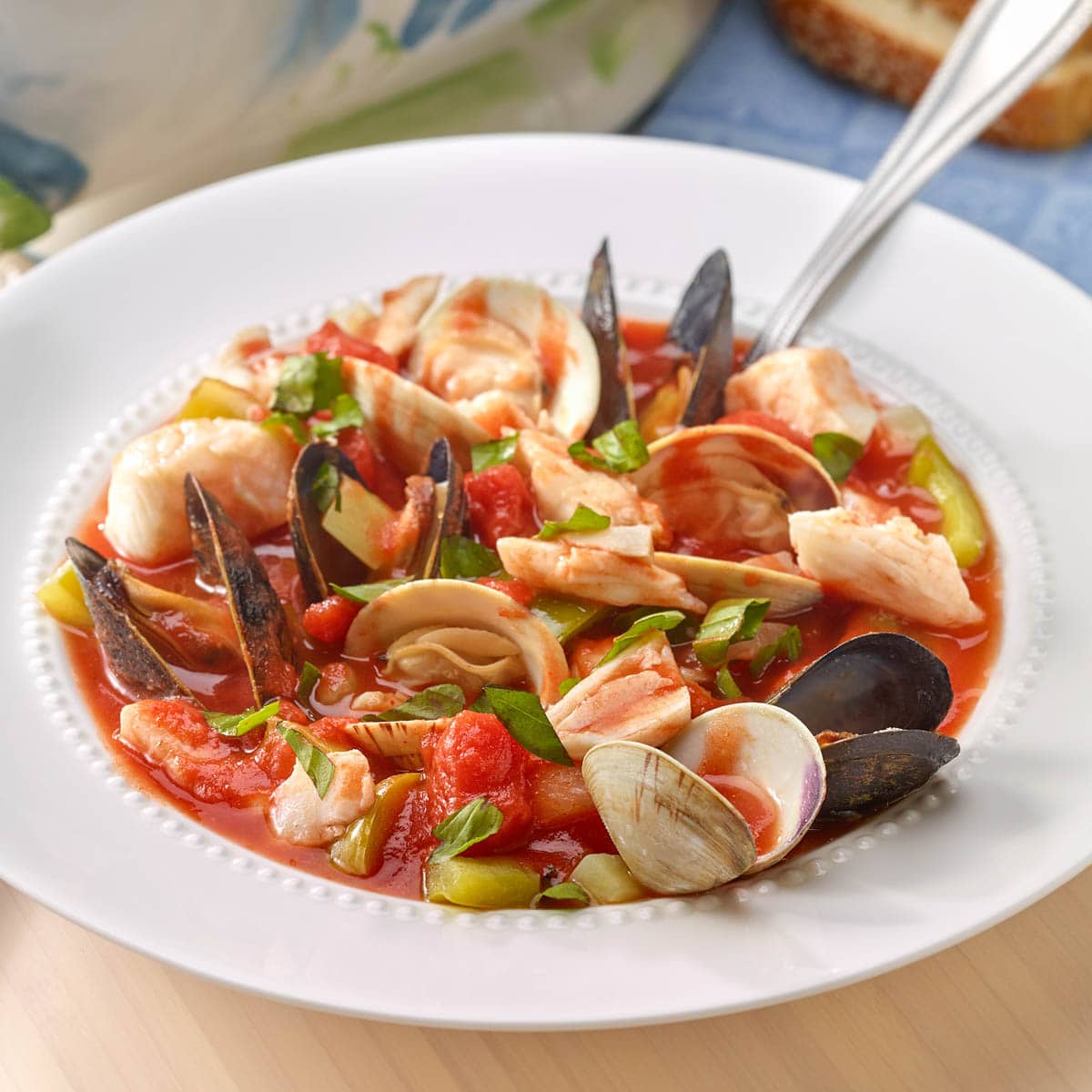
Seafood Bouillabaisse Ingredients
Here’s what you’ll need to make mom’s version of this intensely flavorful dish, which can be found at your local grocery store or fish market:
- Butter – for softening the vegetables and fish, the key flavoring ingredients in the dish’s broth.
- Chopped yellow onions and garlic – traditional ingredients in any bouillabaisse.
- Chopped green bell peppers and celery – these vegetables were added by mom; while not necessary, they add more depth of flavor and a bit of contrasting color.
- Fresh fish – Mom used white fish like sole or flounder, but any firm-fleshed fish will work. Choose what’s sustainably sourced, in season, and not on a watch list.
- Seafood – crabmeat, clams and mussels. For the latter, look for PEI (Prince Edward Island) fresh mussels as they are farm-raised and don’t require as much cleaning. If fresh clams or mussels aren’t available in your area, substitute shrimp.
- Chopped fresh tomatoes – can use canned when fresh aren’t in season.
- Tomato sauce – Mom amped up the tomato flavor by adding tomato sauce. Technically, this makes her recipe somewhat of a hybrid between a bouillabaisse and a cioppino!
- Dry white wine – another traditional ingredient, wine adds acidity and complexity, as well as tenderizes the fish and seafood.
- Clam juice – while not traditional, it enhances the seafood flavor, adding depth to the broth.
- Worcestershire sauce – optional. Honestly, I’m not sure why Mom included this ingredient!
- Dried and fresh herbs, including Italian seasoning, dry oregano, bay leaf, and fresh basil – traditional ingredients in bouillabaisse.
- Cayenne pepper – because mom always liked a bit of spice!
- Seasoned salt (such as Lawry’s) – can use regular salt.
- Saffron – a main ingredient in any bouillabaisse.
Step-by-step Guide to Making Bouillabaisse
Here’s how to create this delicious dish:
- Prep the fish, seafood, and vegetables.
Remove any bones and skin from the fish. Rinse, pat dry, and cut the fish fillets into 1-inch pieces. Scrub the mussels and clams. Peel and chop the onions and garlic. Seed, core and chop the green pepper. Chop the celery and tomatoes. - Soften the vegetables.
In a large saucepan, melt the butter over medium heat. Add the bell pepper, onion, celery, and garlic. Sauté until the pepper and onions begin to soften, stirring occasionally. - Add fish and wine.
Stir in the fish and wine; reduce heat to medium-low and sauté 5 minutes, stirring occasionally. - Add remaining broth ingredients.
Stir in the tomatoes, tomato sauce, water, clam juice, Worcestershire sauce, Italian seasoning, oregano, salt, bay leaf, and saffron. Bring to a boil. - Add seafood.
Gently stir in the crabmeat. Then, add the clams and mussels, reduce the heat to medium-low (maintaining a low boil slightly above a simmer), cover, and cook until the shells open. Discard any shells that remain closed. Keep a close eye on the seafood, as cooking times may vary; stop cooking as soon as the majority of the shells open to prevent overcooking and toughness in the mussels and clams. - Add basil and serve.
Stir in basil and serve immediately in shallow bowls.
Tips for Achieving the Perfect Bouillabaisse
- Use the best quality fresh seafood available. The quality and freshness of the ingredients are key in this dish.
- Experiment with different varieties of fish and shellfish. Bouillabaisse is a versatile dish that can be adapted to your personal tastes and the availability of seafood in your region.
- Store the clams and mussels properly. Keep them on ice in the refrigerator until just before cooking. Make sure to check frequently and drain off any water from melting ice, as they will drown in fresh water. As you clean them, check to make sure the shells are all closed. If any are open, tap on the shell and it should close. If it doesn’t close, throw it away. Also, throw away any broken shells.
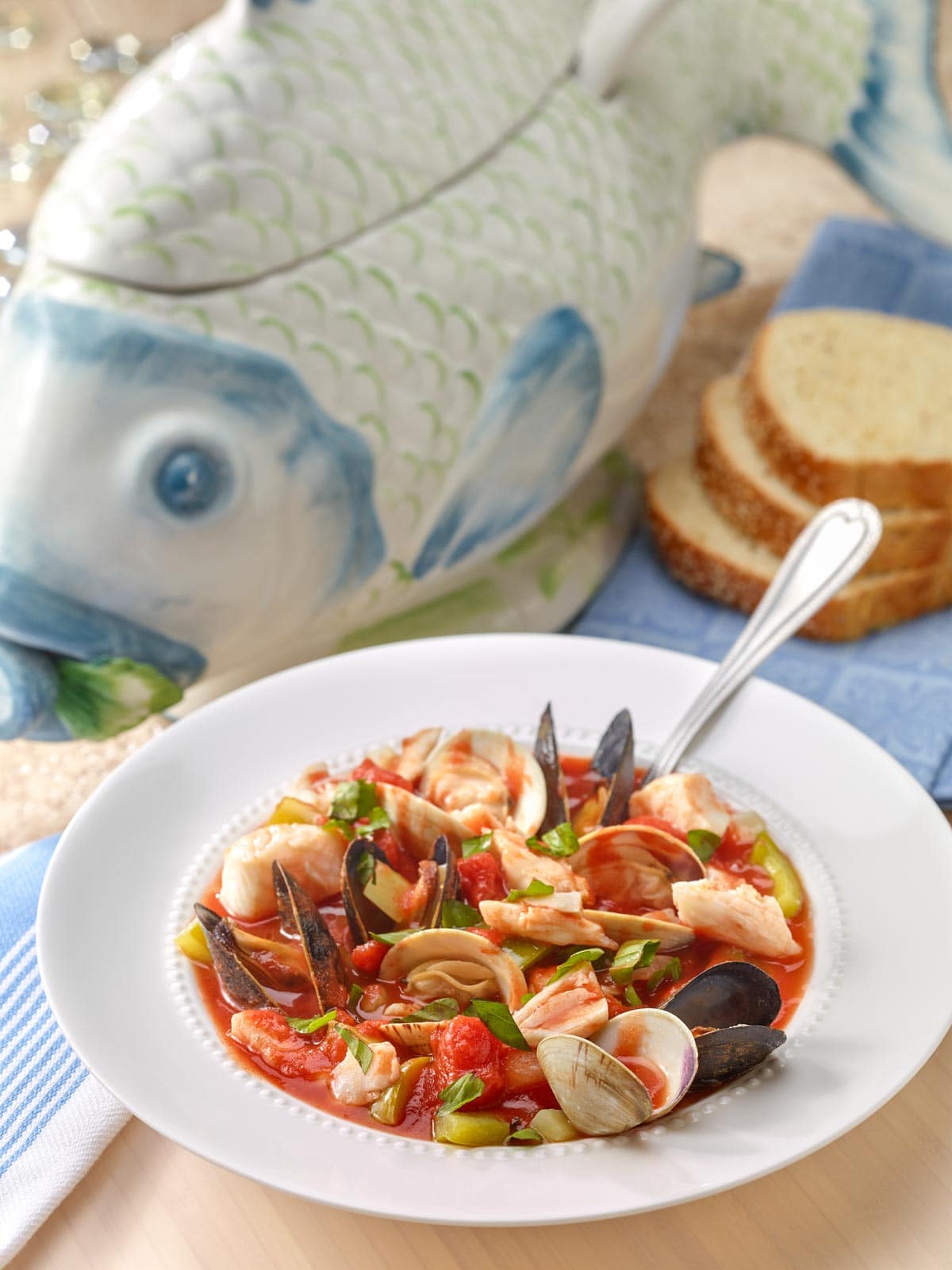
Bouillabaisse Recipe Substitutions and Variations
While I think this recipe is amazing as is, here are a few ways you can modify this recipe and make it your own:
- Add red peppers, chopped leeks, and/or fennel.
- Add shrimp, or use in place of the clams and/or mussels.
- Add fresh thyme leaves to the herbs.
- Use homemade fish stock or seafood stock instead of water and clam juice.
- Use red pepper flakes instead of cayenne pepper.
- Remove the green pepper, celery, and tomato sauce to create a more traditional version of bouillabaisse.
- Just before serving, add a squeeze of fresh lemon juice or a drizzle of olive oil and a grind of black pepper.
How to Serve Bouillabaisse
Bouillabaisse is best served in large bowls. Note that traditional bouillabaisse recipes remove the chopped vegetables before serving the fish and seafood in the strained broth. Mom kept the veggies in, boosting the broth’s flavor.
In terms of side dishes, crusty bread is a must-have when serving bouillabaisse, to soak up all that delicious broth. Choose a French baguette or a rustic loaf with a crispy crust. Alternatively, our Anise Bread or Quick Dinner Rolls are a great choice. I also like to serve it with one of these salads:
- Spinach Salad with Lemon Dijon Dressing
- Spinach Salad with Pine Nut Dressing
- Caesar Salad
- Mixed greens with a Mustard Vinaigrette
Another classic accompaniment to bouillabaisse is Rouille, a traditional Provençal sauce akin to flavored mayonnaise. Typically made with garlic, saffron, cayenne pepper (or red chili peppers), breadcrumbs, egg yolks, and olive oil, Rouille adds a spicy kick to the stew. It can be spread on bread or spooned directly into the dish. There are various Rouille recipes on the web, including a particular delicious-sounding one from Mark Matsumoto on PBS Food.
What Wine Goes with Bouillabaisse
When it comes to bouillabaisse, a crisp white wine is the ideal choice. Look for a wine with good acidity and citrus notes, such as a Sauvignon Blanc or a Chardonnay from the Burgundy region. These wines will cut through the richness of the broth and enhance the flavors of the seafood.
Making Ahead and Storing this Recipe for Bouillabaisse
You can make this Bouillabaisse 1 to 2 days ahead of time and store it in the refrigerator. Cool it to room temperature, transfer to an airtight container, and refrigerate. Gently reheat on the stove top over medium-low heat. Don’t allow it to boil vigorously as you’ll end up overcooking the fish and seafood.
Other Seafood Recipes to Try
- Oven Baked Shrimp with Tomatoes and Feta
- Seafood Phyllo Bundles
- Shrimp and Crab au Gratin
- Seafood Lasagna
- Crab and Shrimp Salad
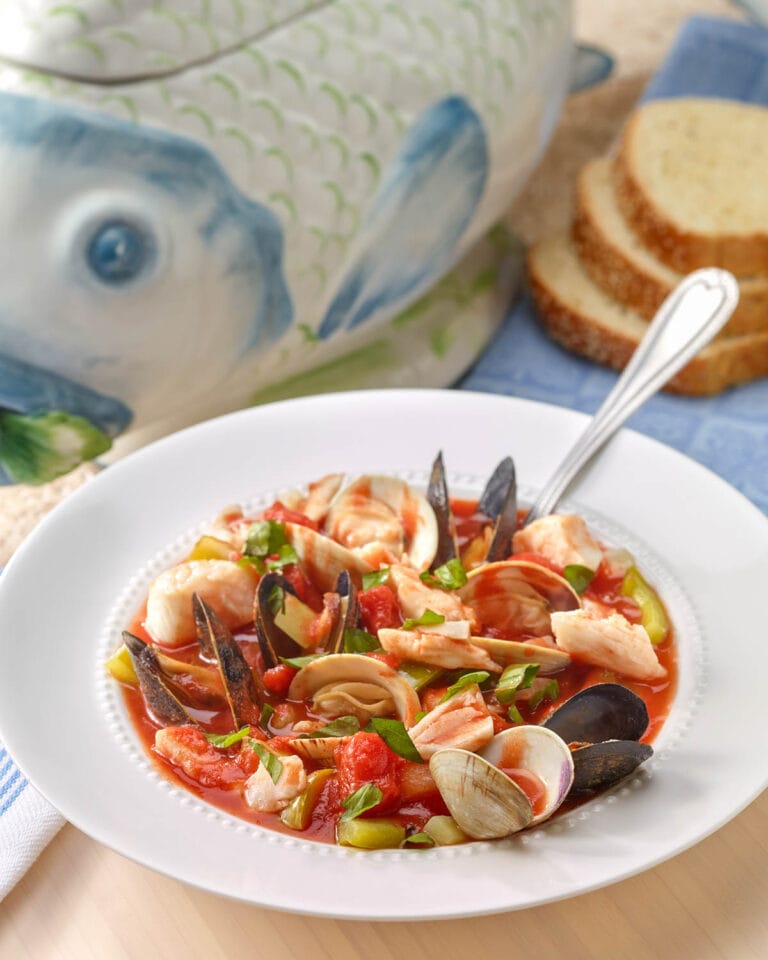
Bouillabaisse Recipe – A French Inspired Seafood Stew
Indulge in the flavors of the Mediterranean with our irresistible Bouillabaisse recipe! This French inspired seafood stew offers a taste of the Mediterranean in every spoonful by combining fresh fish and seafood with a fragrant blend of onions, peppers, tomatoes, garlic, saffron, wine, and an assortment of herbs. Our version was created by my mom, and it’s faster and easier than other, more traditional bouillabaisse recipes.
- Prep Time: 10 minutes (chopping)
- Cook Time: 30 minutes
- Total Time: 40 minutes
- Yield: 8 servings 1x
- Diet: Gluten Free
Ingredients
- 4 tablespoons butter
- 1 cup (1 large) chopped green bell pepper
- 1 cup (1/2 large) chopped yellow onion
- 1 cup (about 3 large stalks) chopped celery
- 1 1/2 teaspoons chopped garlic (around 3 cloves garlic)
- 2 pounds sole or flounder fillet, skin and bones removed, cut into 1-inch pieces
- 2 cups dry white wine
- 1 3/4 cups chopped fresh tomatoes – see Note
- 2 (15-ounce) cans tomato sauce
- 2 cups water
- 3/4 cup clam juice
- 1/2 teaspoon Worcestershire sauce
- 1/2 teaspoon Italian seasoning
- 1/2 teaspoon dried oregano
- 1 teaspoon cayenne pepper
- 1/4 teaspoon seasoned salt (such as Lawry’s)
- 1 bay leaf
- Pinch or two of saffron
- 1 pound fresh crabmeat, rinsed and drained
- 24 small hard-shelled clams, scrubbed, tossing any opened shells (see Tip)
- 24 PEI fresh mussels, scrubbed – see Note
- 1 heaping tablespoon chopped fresh basil
Instructions
- In a large saucepan, melt the butter over medium heat. Add the bell pepper, onion, celery, and garlic. Sauté 5 minutes or until pepper and onions begin to soften.
- Add the fish and wine; reduce heat to medium-low and sauté 5 minutes.
- Stir in the tomatoes, tomato sauce, water, clam juice, Worcestershire sauce, Italian seasoning, oregano, salt, bay leaf and saffron. Bring to a boil.
- Gently stir in the crabmeat. Then, add the clams and mussels, reduce the heat to medium-low (maintaining a low boil slightly above a simmer), cover, and cook 10 to 15 minutes or until the shells open. Discard any shells that remain closed. Keep a close eye on the seafood, as cooking times may vary; stop cooking as soon as the majority of the shells open to prevent overcooking and toughness in the mussels and clams.
- Stir in basil and serve immediately in shallow bowls.
Notes
Note on tomatoes: When fresh tomatoes aren’t in season, for more flavor substitute 1 (15-ounce) can diced tomatoes, drained.
Note on mussels: PEI (Prince Edward Island) mussels are farm-raised and don’t require much cleaning. Wild mussels may be muddy, with long “beards” — the tendrils that hold them onto rocks and piers. Scrub vigorously under cold water, tossing any with broken shells or that fail to close tightly.
Make ahead: You can make this Bouillabaisse 1 to 2 days ahead of time and store it in the refrigerator. Cool it to room temperature, transfer to an airtight container, and refrigerate. Gently reheat on the stove top over medium-low heat. Don’t allow it to boil vigorously as you’ll end up overcooking the fish and seafood.
Dairy free: substitute olive oil for the butter.
- Category: Main dish
- Method: Stovetop
- Cuisine: French
Nutrition
- Serving Size: 1 bowlful
- Calories: 424
- Sugar: 7 g
- Sodium: 884 mg
- Fat: 14.8 g
- Saturated Fat: 5 g
- Carbohydrates: 16.4 g
- Fiber: 3.1 g
- Protein: 45 g
- Cholesterol: 140 mg
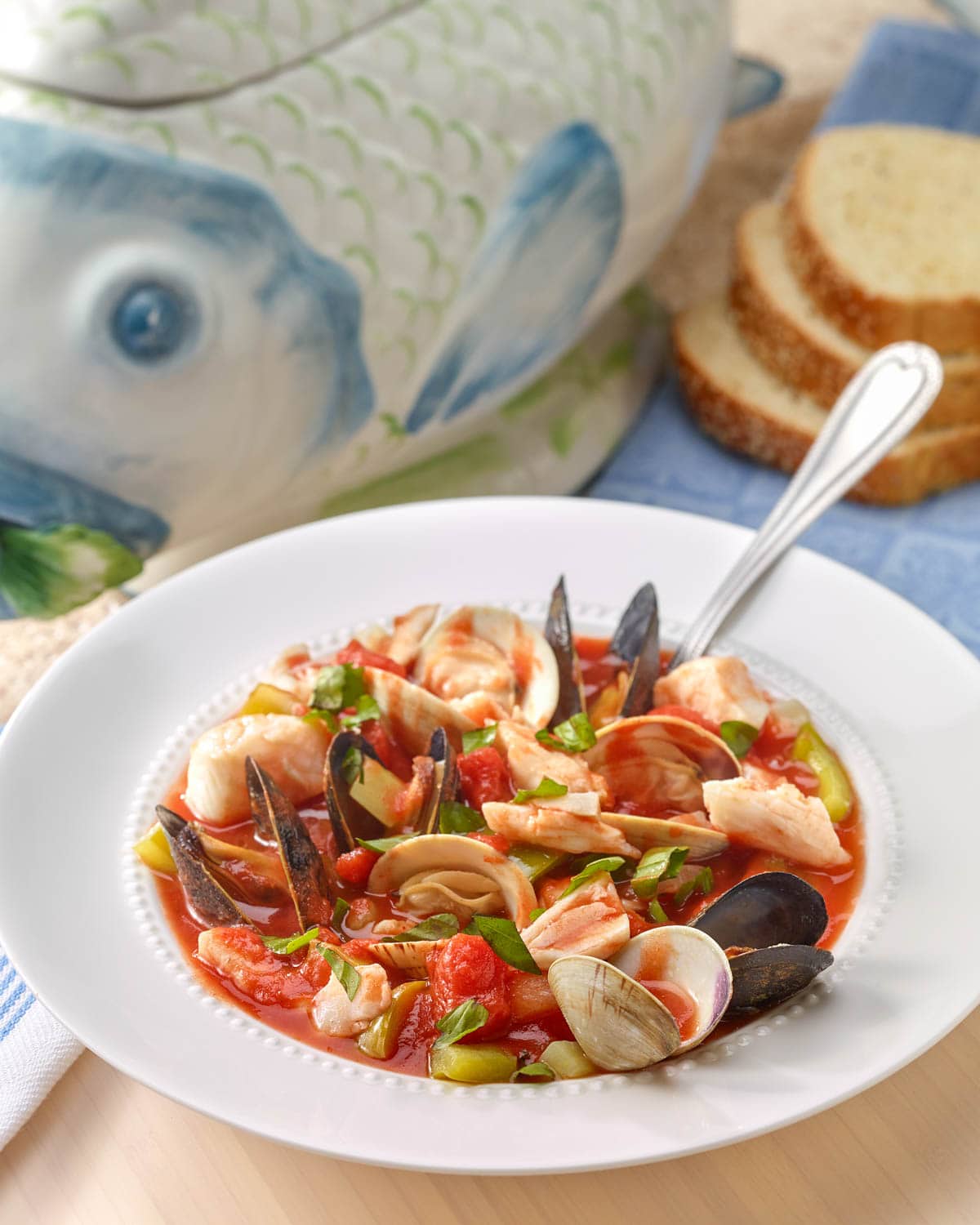
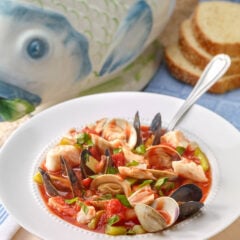
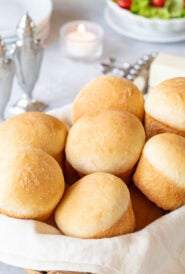



Hi Lee, Excellent recipe – at least equal, if not better than, the Bouillabaisse we had at a restaurant at the harbor in Marseille last April! We took your suggestions and made a few changes, after adjusting the recipe for 4 servings and what seafood was fresh and available:
– additional mussels and shrimp (jumbo size) in lieu of clams
– more clam juice
– just a little larger quantity of the spices including cayenne pepper (we like 3-alarm chili, etc.)
Hi Pat and Bill, So happy to hear you liked Mom’s recipe! And great adaptions, too.